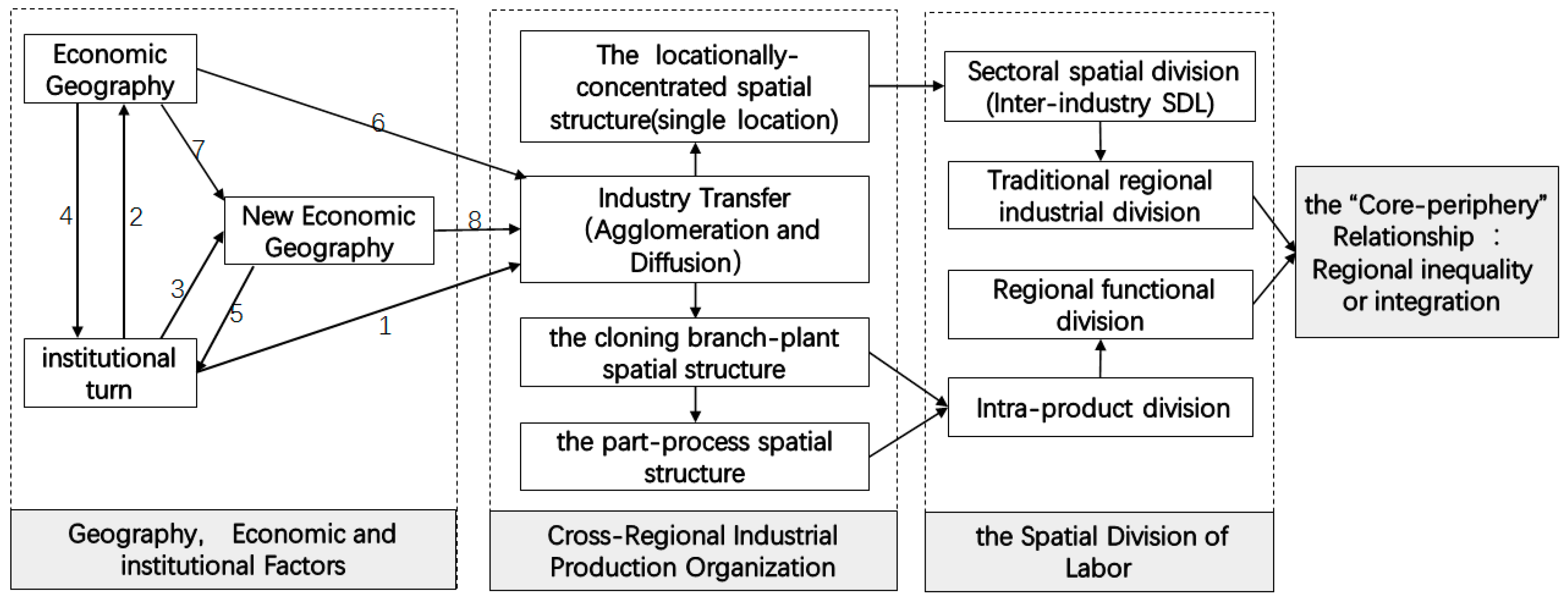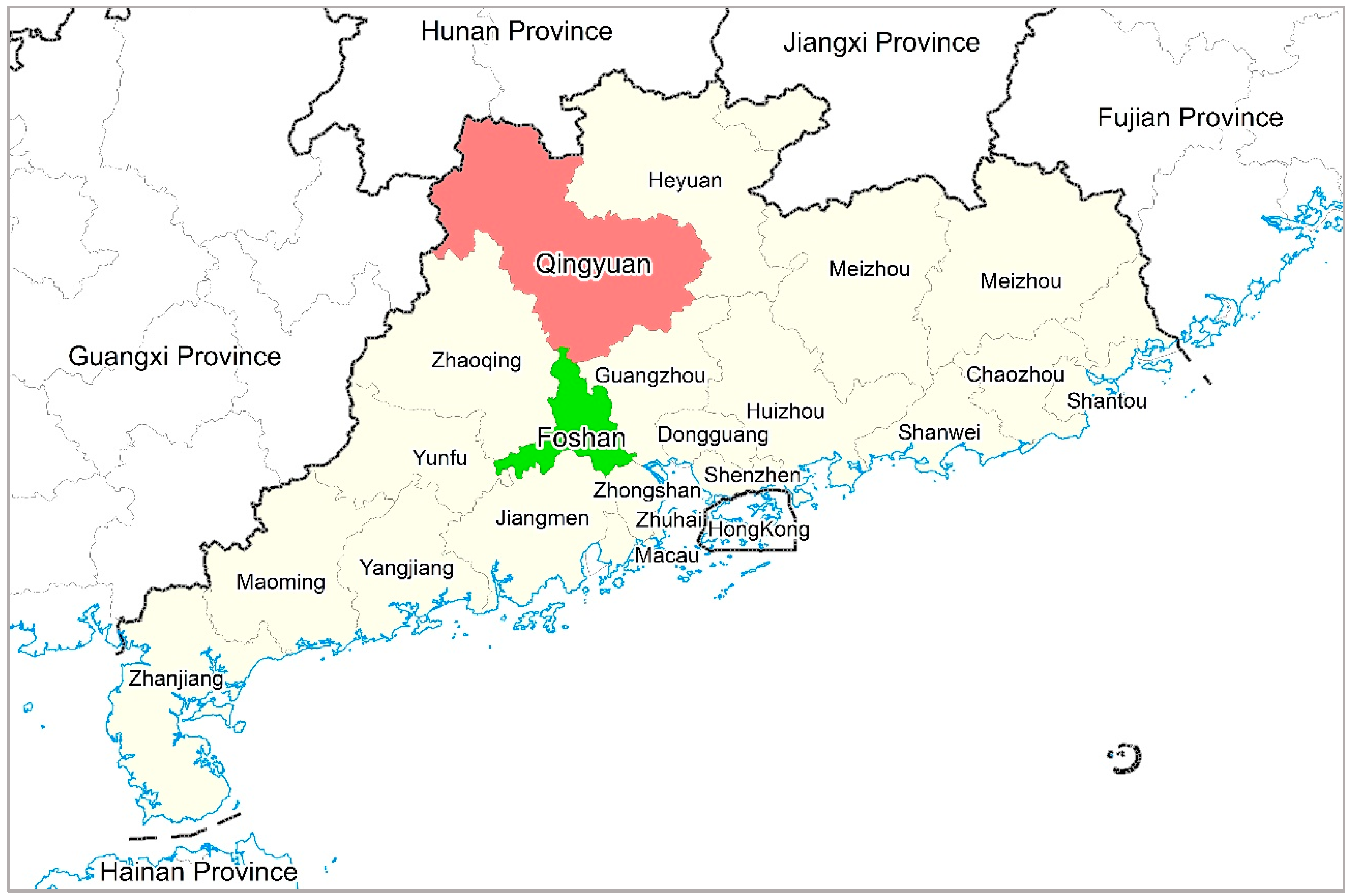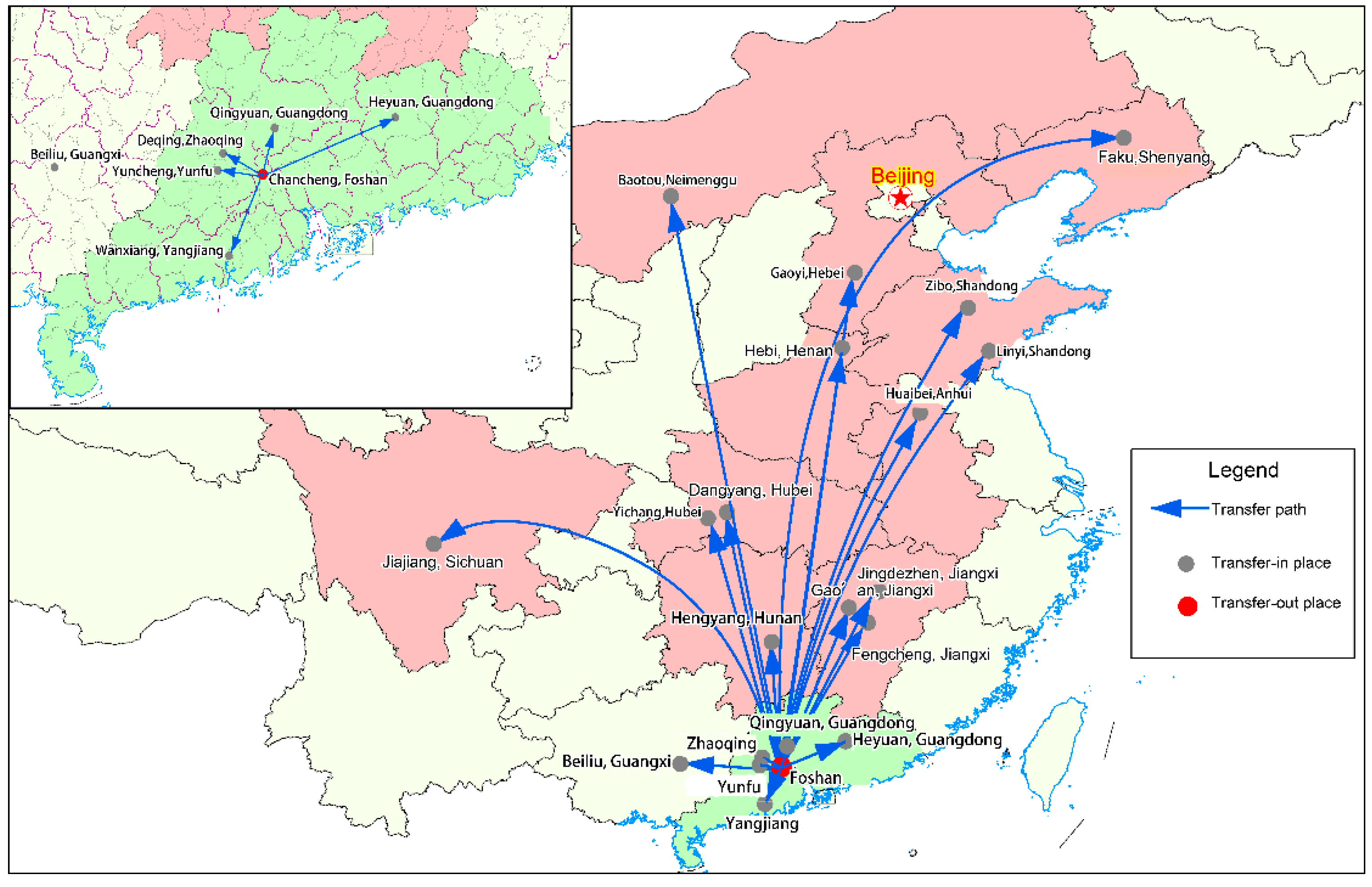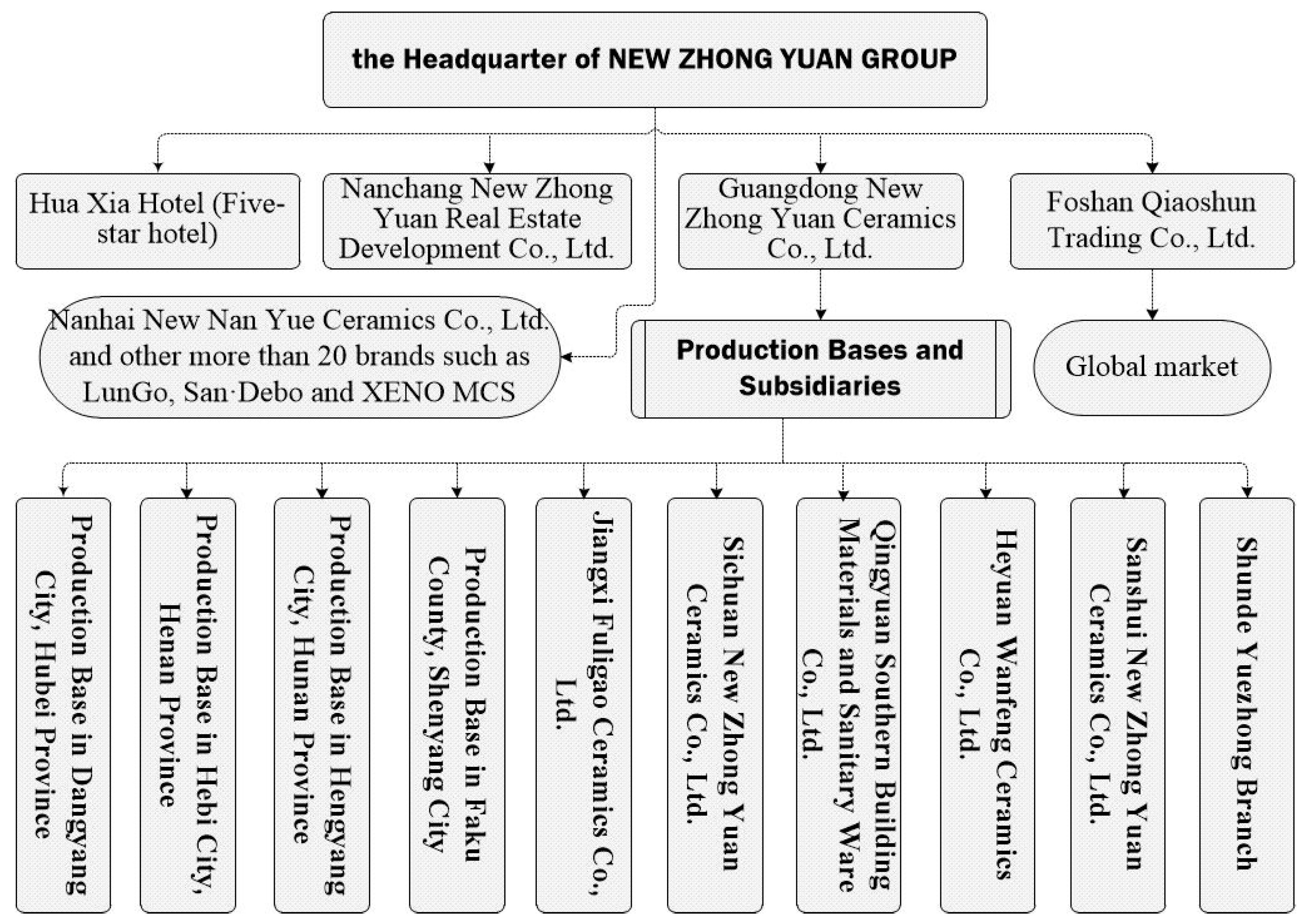Evolution and Mechanism of the “Core–Periphery” Relationship: Micro-Evidence from Cross-Regional Industrial Production Organization in a Fast-Developing Region in China
Abstract
1. Introduction
2. Theoretical Framework
3. Research Areas and Methods
3.1. Research Areas
3.2. Research Methods
4. The Process and Mechanism of Cross-Regional Spatial Organization of Foshan–Qingyuan Ceramic Enterprises
4.1. Spatio-Temporal Process of Foshan–Qingyuan Ceramic Industry Migration
4.1.1. The Scale Expansion Stage of Foshan–Qingyuan Ceramic Industry before 2006
4.1.2. The Shrinkage Stage of Foshan–Qingyuan Ceramic Industry under the Regulations from 2007 to 2010
4.1.3. The Internal Adjustment Stage of the Foshan–Qingyuan Ceramic Industry from 2011 to 2017
4.2. Evolution of Production Space Organization of Ceramic Enterprises: A Case Study
4.3. Analysis of Regional Effect and Mechanism
4.3.1. Micro Mechanism Analysis of Enterprises Production Space Organization
4.3.2. Macro Mechanism Analysis of Regional Effect
5. Conclusions and Discussion
Author Contributions
Funding
Conflicts of Interest
References
- Coe, N.; Hess, M.; Yeung, H.W.C.; Dicken, P.; Henderson, J. ‘Globalizing’ regional development: A global production networks perspective. Trans. Inst. Br. Geogr. 2004, 29, 468–484. [Google Scholar] [CrossRef]
- Wei, Y.H.D. Multiscale and multi-mechanisms of regional inequality in China: Implications for regional policy. J. Contemp. China 2002, 11, 109–124. [Google Scholar] [CrossRef]
- Liao, F.H.F.; Wei, Y.H.D. Dynamics, space, and regional inequality in provincial China: A case study of Guangdong Province. Appl. Geogr. 2012, 35, 71–83. [Google Scholar] [CrossRef]
- Diao, X.D.; Zeng, S.X.; Tam, C.M.; Tam, V.W.Y. EKC analysis for studying economic growth and environmental quality: A case study in China. J. Clean. Prod. 2009, 17, 541–548. [Google Scholar] [CrossRef]
- Grossman, G.M.; Krueger, A.B. Environmental impacts of a North American free trade agreement. In The Mexico-U.S. Free Trade Agreement; MIT Press: Cambridge, MA, USA, 1993; pp. 13–56. [Google Scholar]
- Copeland, B.R.; Taylor, M.S. Trade, growth, and the environment. J. Econ. Lit. 2004, 42, 7–71. [Google Scholar] [CrossRef]
- Liu, L. Geographic approaches to resolving environmental problems in search of the path to sustainability: The case of polluting plant relocation in China. Appl. Geogr. 2013, 45, 138–146. [Google Scholar] [CrossRef]
- Söderbaum, F. Introduction: Theories of New Regionalism. In Theories of New Regionalism. International Political Economy Series; Söderbaum, F., Shaw, T.M., Eds.; Palgrave Macmillan: London, UK, 2003. [Google Scholar]
- Mckeon, H.; Johnston, K.; Henry, C. Multinational Companies as a Source of Entrepreneurial Learning: Examples from the IT Sector in Ireland. Educ. Train. 2013, 46, 433–443. [Google Scholar] [CrossRef]
- Wei, Y.H.D.; Jun, L.; Qiang, Z. Location decisions and network configurations of foreign investment in urban China. Prof. Geogr. 2010, 62, 264–283. [Google Scholar] [CrossRef]
- Ang, Y.Y. Industrial Transfer and the Remaking of the People’s Republic of China’s Competitive Advantage; ADBI Working Paper 762; Asian Development Bank Institute: Tokyo, Japan, 2017; pp. 1–17. [Google Scholar]
- Ang, Y.Y. How China Escaped the Poverty Trap; Ithaca, N.Y., Ed.; Cornell University Press: Ithaca, NY, USA, 2016. [Google Scholar]
- Wei, Y.H.D. Regional inequality in China. Prog. Hum. Geogr. 1999, 23, 49–59. [Google Scholar] [CrossRef]
- Wei, Y.H.D. Regional development in China: Transitional institutions, embedded globalization, and hybrid economies. Eurasian Geogr. Econ. 2007, 48, 16–36. [Google Scholar] [CrossRef]
- Wei, Y.H.D.; Yuqi, L.; Wen, C. Globalizing Regional Development in Sunan, China: Does Suzhou Industrial Park Fit a Neo-Marshallian District Model? Reg. Stud. 2009, 43, 409–427. [Google Scholar]
- Lu, L.; Wei, Y.D. Domesticating Globalization, New Economic Spaces, and Regional Polarization in Guangdong Province, China. Soc. Sci. Electron. Publ. 2007, 98, 225–244. [Google Scholar]
- Yang, C. Restructuring the export-oriented industrialization in the Pearl River Delta, China: Institutional evolution and emerging tension. Appl. Geogr. 2012, 32, 143–157. [Google Scholar] [CrossRef]
- He, C.; Wang, J. Regional and sectoral differences in the spatial restructuring of Chinese manufacturing industries during the post-WTO period. Geojournal 2012, 77, 361–381. [Google Scholar] [CrossRef]
- Zhu, S.; He, C. Geographical dynamics and industrial relocation: Spatial strategies of apparel firms in Ningbo, China. Eurasian Geogr. Econ. 2013, 54, 342–362. [Google Scholar] [CrossRef]
- Duan, X.W.; Li, L.L.; Miao, C.H.; Hu, Z.Q. Evaluation of Industry Transfer Comprehensive Undertaking Ability of Six Major Urban Agglomerations in the Central Region. Sci. Geogr. Sin. 2016, 36, 681–690. [Google Scholar]
- Feng, M.; Yu, K.H.; Hao, R. Evaluation of Regional Industry Transfer Undertaking Ability Based on Sustainable Development. J. Sci. Ind. Res. 2017, 76, 269–272. [Google Scholar]
- Shen, J.; Wei, Y.D.; Yang, Z. The impact of environmental regulations on the location of pollution-intensive industries in China. J. Clean. Prod. 2017, 148, 785–794. [Google Scholar] [CrossRef]
- Lin, S.L.; Lu, J.; Su, J.B.; Chen, W.P. Sustainable Returns: The Effect of Regional Industrial Development Policy on Institutional Investors’ Behavior in China. Sustainability 2018, 10, 2769. [Google Scholar] [CrossRef]
- Lewis, W.A. The state of development theory. Am. Econ. Rev. 1984, 74, 1–10. [Google Scholar]
- Dunning, J.H. Trade, location of economic activity and the MNE: A search for an eclectic approach. In The International Allocation of Economic Activity; Ohlin, B., Hesselborn, P.O., Wijkman, P.M., Eds.; Macmillan: London, UK, 1977. [Google Scholar]
- Amin, A.; Thrift, N. What Kind of Economic Theory for what Kind of Economic Geography? Antipode 2000, 32, 4–9. [Google Scholar] [CrossRef]
- Krugman, P. Geography and Trade; Leuven University Press: Leuven, Belgium, 1991. [Google Scholar]
- Krugman, P. First nature, second nature and metropolitan location. J. Reg. Sci. 1993, 3, 129–144. [Google Scholar] [CrossRef]
- Krugman, P. Complex landscape in economic geography. Am. Econ. Rev. 1994, 84, 412–415. [Google Scholar]
- Venables, A.J. Localization of industry and trade performance. Oxf. Rev. Econ. Policy 1996, 12, 52–60. [Google Scholar] [CrossRef]
- Brulhart, M. Economic Geography, Industry Location and Trade: The Evidence. World Econ. 1998, 21, 775–801. [Google Scholar] [CrossRef]
- Martin, R. The New ‘Geographical Turn’ in Economics: Some Critical Reflections. Camb. J. Econ. 1999, 23, 65–91. [Google Scholar] [CrossRef]
- Fujita, M.; Thisse, J. New Economic Geography: An appraisal on the occasion of Paul Krugman’s 2008 Nobel Prize in Economic Sciences. Reg. Sci. Urban Econ. 2008, 39, 109–119. [Google Scholar] [CrossRef]
- Ottaviano, G.I.P.; Puga, D. Agglomeration in the Global Economy: A Survey of the ‘New Economic Geography’. World Econ. 1998, 21, 707–731. [Google Scholar] [CrossRef]
- Fujita, M.; Krugman, P.; Venables, A.J. The Spatial Economy: Cities, Regions and International Trade; MIT Press: Cambridge, MA, USA, 1999. [Google Scholar]
- Amin, A. An institutionalist perspective on regional economic development. Int. J. Urban Reg. Stud. 1999, 2, 365–378. [Google Scholar] [CrossRef]
- Amin, A. Flexible Specialization and Small Firms in Italy: Maths and Realities. In Industrial Districts and Inter-Firm Cooperation in Italy; Pyke, F., Becattni, G., Sengenberger, W., Eds.; ILO: Geneva, Switzerland, 1989; pp. 185–219. [Google Scholar]
- Scott, A.J. New Industrial Spaces: Flexible Production Organization and Regional Development in North American and Western Europe; Pion: London, UK, 1988. [Google Scholar]
- Markusen, A. Sticky places in slippery space: A typology of industrial distracts. Ecol. Geogr. 1996, 72, 293–313. [Google Scholar] [CrossRef]
- Morgan, K. The learning region: Institutions, innovation and regional renewal. Reg. Stud. 1997, 31, 491–503. [Google Scholar] [CrossRef]
- Aydalot, P. Milieux Innovateurs en Europe; Gremi: Paris, France, 1986. [Google Scholar]
- Cooke, P. Regional innovation Systems: An Evaluation of Six European Cases. In Urban and Regional Development in the New Europe; Getimis, P., Kafkalas, G., Eds.; Topos: Athens, Greece, 1993; pp. 133–154. [Google Scholar]
- Peck, J.A.; Tickell, A. Local modes of social regulation? Regulation theory, Thatcherism and uneven development. Geoforum 1994, 23, 347–383. [Google Scholar] [CrossRef]
- Martin, R. Institutional approaches in economic geography. In A Companion to Economic Geography; Tbarnes, E.S., Ed.; Blackwell: Oxford, UK, 2000; pp. 77–94. [Google Scholar]
- Caballero, G.; Arias, X.C. Transaction Cost Politics in the Map of the New Institutionalism. In Advances in Political Economy: Institutions, Modelling and Empirical Analysis; Schofield, N., Caballero, G., Kselman, D., Eds.; Springer: Berlin, Germany, 2012; pp. 3–29. [Google Scholar]
- Farole, T.; Rodriguez-Pose, A.; Storper, M. Human geography and the institutions that underlie economic growth. Prog. Hum. Geogr. 2011, 35, 58–80. [Google Scholar] [CrossRef]
- Feils, D.J.; Rahman, M. The Impact of Regional Integration on Insider and Outsider FDI. Manag. Int. Rev. 2011, 51, 41–63. [Google Scholar] [CrossRef]
- Massey, D. In what sense a regional problem? Reg. Stud. 1979, 13, 233–243. [Google Scholar] [CrossRef]
- Massey, D. Spatial Divisions of Labor: Social Structures and the Geography of Production; Macmillan: London, UK, 1984. [Google Scholar]
- Massey, D. Uneven Development: Social Change and Spatial Divisions of Labor. In Uneven Re-Development: Cities and Regions in Transition; Massey, D., Allen, J., Eds.; Hodder and Stoughton: London, UK, 1988. [Google Scholar]
- Tonts, M.; Plummer, P.; Taylor, M. Power, enterprise and employment growth in Australian small-and medium-sized manufacturing firms. J. Econ. Geogr. 2012, 12, 1239–1266. [Google Scholar] [CrossRef]
- Amin, A.; Thrift, N. Living in the Global, in Globalization. In Institutions, and Regional Development in Europe; Amin, A., Thrift, N., Eds.; Oxford University Press: Oxford, UK, 1994; pp. 1–22. [Google Scholar]
- Macleod, D. Beyond soft institutionalism: Accumulation, regulation, and their geographical fixes. Environ. Plan. A 2001, 33, 1145–1167. [Google Scholar] [CrossRef]
- Martin, R. Institutional Approaches in Economic Geography. In A Companion to Economic Geography; John Wiley & Sons, Ltd.: Hoboken, NJ, USA, 2008. [Google Scholar]
- MacKinnon, D.; Cumbers, A.; Pike, A.; Birch, K.; McMaster, R. Evolution in Economic Geography: Institutions, Political Economy, and Adaptation. Econ. Geogr. 2009, 85, 129–150. [Google Scholar] [CrossRef]
- Ottaviano, G. Regional policy in the global economy: Insights from new economic geography. Reg. Stud. 2003, 37, 665–673. [Google Scholar] [CrossRef]
- Ihori, T.; Yang, C.C. Interregional tax competition and intraregional political competition: The optimal provision of public goods under representative democracy. J. Urban Econ. 2009, 66, 210–217. [Google Scholar] [CrossRef][Green Version]
- Zheng, X.P. Economies of Network, Urban Agglomeration, and Regional Development: A Theoretical Model and Empirical Evidence. Reg. Stud. 2007, 41, 559–569. [Google Scholar] [CrossRef]
- Puga, D. Agglomeration and Cross-Border Infrastructure; IMDEA, Universidad Carlos III and CEPR: Madrid, Spain, 2009; p. 06. [Google Scholar]
- Becker, J.; Fuest, C. Eu regional policy and tax competition. Eur. Econ. Rev. 2010, 54, 150–161. [Google Scholar] [CrossRef]
- Dupont, V.; Martin, P. Subsidies to poor regions and inequalities: Some unpleasant arithmetic. J. Econ. Geogr. 2006, 6, 223–240. [Google Scholar] [CrossRef]
- Toulemonde, E. Acquisition of skills, labor subsidies, and agglomeration of firms. J. Urban Econ. 2006, 59, 420–439. [Google Scholar] [CrossRef]
- Rodríguez-Pose, A. Do institutions matter for regional development? Reg. Stud. 2013, 47, 1034–1047. [Google Scholar] [CrossRef]
- Markusen, A. Studying regions by studying firms. Prof. Geogr. 1994, 46, 477–490. [Google Scholar] [CrossRef]





| Centripetal Forces | Centrifugal Forces |
|---|---|
| Linkage | Immobile factors |
| Thick markets | Land rents/commuting |
| Knowledge spillover and other pure external economies | Congestion and other pure diseconomies |
| Interviewees | Number of Interviewees | Interview Time | Enterprises and Institutions | Year and Mode of Transfer-in, Headquarters and Transfer-in Industrial Parks |
|---|---|---|---|---|
| Enterprise managers | 4 | 2010–2011 | Guangdong New Zhong Yuan Ceramics Co., Ltd. | 2002–2005, Expansion, Foshan-Yuantan Ceramic Industrial Park |
| 2 | 2010–2011 | Qingyuan Southern Building Materials and Sanitary Ware Co., Ltd. | ||
| 3 | 2010–2011 | Foshan Dongpeng Ceramic Co., Ltd. | ||
| 3 | 2010–2011 | Guangdong Qingyuan Monalisa Ceramics Co., Ltd. | ||
| 2 | 2010–2011 | Guangdong Hongyu Ceramics Co., Ltd. | ||
| 2 | 2010–2011 | Guangdong Guanxing Ceramic Group | ||
| 2 | 2010–2011 | Guangdong Jiamei Ceramics Co., Ltd. | ||
| 1 | 2010–2011 | Guangdong Bohua Ceramic Co., Ltd. | 2004, Partial relocation, Foshan-production base in Fogang County | |
| 2 | 2010–2011 | Guangdong Homeway Ceramics Industry Co., Ltd. | 2008, Partial relocation, Foshan-Yuantan Ceramic Industrial Park | |
| 2 | 2010–2011 | Qingyuan Juncheng Ceramics Co., Ltd. | 2008–2010, Partial relocation, Foshan-Foshan Chancheng (Qingxin) Industrial Transfer Park | |
| 2 | 2010–2011 | Qingyuan Tianyu Ceramics Co., Ltd. | ||
| 1 | 2011 | Qingyuan Megacers Ceramics Co., Ltd. | ||
| 3 | 2011 | Guangdong Simpire Building Materials Co., Ltd. | 2010, Expansion, Foshan-Foshan Chancheng (Qingxin) Industrial Transfer Park | |
| 1 | 2011 | Qingyuan Ganglong Ceramics Co., Ltd. | 2011, Expansion, Dongguan-Foshan Chancheng (Qingxin) Industrial Transfer Park | |
| Administrators of industrial parks management committee | 3 | 2010–2011 | Yuantan Ceramic Industrial Park | - |
| 2 | 2010–2011 | production base in Fogang County | - | |
| 4 | 2010–2011 2015 | Foshan Chancheng (Qingxin) Industrial Transfer Park | - | |
| Government officials | 15 | 2010–2011 2015 | Government Departments Related to Industrial Economic Development and Environmental Protection | - |
| Annual | The Quantity of Industry above Designated Size (Unit) | The Gross Output Value of Industry above Designated Size (100 Million Dollars) | The Average Output Value of Industry above Designated Size (100 Million Dollars per Unit) | The Ratio of Gross Output Value between Foshan and Qingyuan | |||
|---|---|---|---|---|---|---|---|
| Foshan | Qingyuan | Foshan | Qingyuan | Foshan | Qingyuan | ||
| 2000 | 342 | 53 | 23.33 | 1.64 | 0.07 | 0.03 | 14.21 |
| 2005 | 513 | 72 | 60.38 | 5.53 | 0.12 | 0.08 | 10.92 |
| 2010 | 503 | 123 | 140.59 | 65.61 | 0.28 | 0.53 | 2.14 |
| 2015 | 438 | 113 | 191.08 | 45.83 | 0.44 | 0.41 | 4.17 |
| 2017 | 453 | 119 | 193.08 | 42.93 | 0.43 | 0.36 | 4.50 |
| Year | Stage | Change in Production Location | Production Spatial Organization | Functional Division |
|---|---|---|---|---|
| 1984–1999 | Establishment period | Macao-Shunde District and Sanshui District, Foshan City | The location-concentrated spatial structure | Centralized management, production and sale |
| 2000–2006 | Early stage of expansion | Jiajiang County, Leshan City, Sichuan Province and Heyuan City and Qingyuan City, Guangdong Province | The cloning branch-plant spatial structure and the part–process spatial structure: Head office + branches (production bases) | Coexisting administration hierarchy of headquarters—branch and internal hierarchy of production process |
| 2007–Now | Expansion and adjustment period | Hengyang City, Hunan Province, Gaoan City, Jiangxi Province, Dangyang City, Hubei Province, Faku County, Shenyang City and Hebi City, Henan Province | Networking group spatial structure: Headquarters + branches + national production network + global sales network | Coexisting administration hierarchy of headquarters—subsidiary branch and internal hierarchy of production process |
© 2019 by the authors. Licensee MDPI, Basel, Switzerland. This article is an open access article distributed under the terms and conditions of the Creative Commons Attribution (CC BY) license (http://creativecommons.org/licenses/by/4.0/).
Share and Cite
Jin, L.; Wang, C.; Zhang, H.; Ye, Y.; Du, Z.; Zhang, Y. Evolution and Mechanism of the “Core–Periphery” Relationship: Micro-Evidence from Cross-Regional Industrial Production Organization in a Fast-Developing Region in China. Sustainability 2020, 12, 189. https://doi.org/10.3390/su12010189
Jin L, Wang C, Zhang H, Ye Y, Du Z, Zhang Y. Evolution and Mechanism of the “Core–Periphery” Relationship: Micro-Evidence from Cross-Regional Industrial Production Organization in a Fast-Developing Region in China. Sustainability. 2020; 12(1):189. https://doi.org/10.3390/su12010189
Chicago/Turabian StyleJin, Lixia, Changjian Wang, Hongou Zhang, Yuyao Ye, Zhiwei Du, and Yuling Zhang. 2020. "Evolution and Mechanism of the “Core–Periphery” Relationship: Micro-Evidence from Cross-Regional Industrial Production Organization in a Fast-Developing Region in China" Sustainability 12, no. 1: 189. https://doi.org/10.3390/su12010189
APA StyleJin, L., Wang, C., Zhang, H., Ye, Y., Du, Z., & Zhang, Y. (2020). Evolution and Mechanism of the “Core–Periphery” Relationship: Micro-Evidence from Cross-Regional Industrial Production Organization in a Fast-Developing Region in China. Sustainability, 12(1), 189. https://doi.org/10.3390/su12010189




